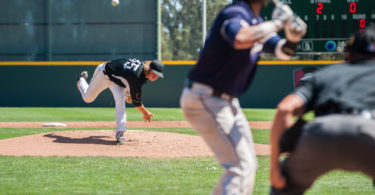Base running is something that requires a lot of practice. There is no substitute for experience, but you can get a lot better by knowing what to do, visualizing the situation, and thinking through it. In this last installment of our base running series, we address five mistake-ridden situations that base runners are likely to encounter. In these situations, runners face difficult decisions and we see a lot of base running mistakes. In this post, we will share some examples and tips to help you make better decisions next time you find yourself in one or more of these spots.
Situation #1: You are at 2nd base and there is a deep fly ball hit that forces the outfielder to turn and run for the ball. Should you tag up or extend?
This is a situation that you are sure to encounter time and again. While your coach may have a specific system that helps you remember what he wants you to do, following these simple rules will help you make sound decisions without hesitation. Remember, you should always watch the ball! If you see that the ball can’t be caught, there is no longer any need to hang out on the base, even if you went back to tag—extend or go.
With 0 outs: As soon as the fly ball is hit, your immediate reaction needs to be to go back and tag up. Even if the ball looks like it is sure to drop, you can keep judging this as you make your way back to the base. Get back to the base while reading the ball. If you see the ball is sure to drop, go. In this situation, you want to eliminate the possibility of the outfielder making a tremendous play and you are still stuck at second, or worse, doubled off. Getting to 3rd with less than 2 outs means that you can score without your team getting a hit and that is a situation most coaches will take every time. What is more likely to happen is as you read the play and see the ball will drop, you go and score easily. If the ball falls in this situation and you are still standing on 2nd that means the outfielder almost made the catch. In this case, there is still a chance that you score, and worst case you are 90 feet away from scoring with no outs.
With 1 out: When the ball is hit, you need to extend as far as the play allows and continue to read the ball. If you determine it will fall, you will score easily. If you have to stay and read it, you are still likely to score if it is not caught. If it is caught and you don’t have time to get back and tag, you are in scoring position with 2 outs, which is where you want to be. What you don’t want to have happen is be standing on second waiting to tag when the ball drops and be unable to score on a double.
Situation #2: You are at 1st, and a seemingly easy-to-catch fly ball is hit. The outfielder has time to get under it and you know you can’t tag, so you get as far as you can and wait.
This is another situation you are sure to encounter. It is also a situation where players tend to assume the outfielder will catch the ball, so they get lazy. Often, the runner will put his head down and start making his way back to 1st before the catch is even secured. We have all seen it happen. The outfielder comes in, looks camped under the ball, the ball does something unexpected, the outfielder drops it, but still has time to throw the lead runner out at 2nd because they were flat footed or on their way back to 1st .
The best choice is to shorten how far you get out and increase your momentum by stepping into the catch. Shorten the distance towards 2nd by a step or two. As the ball is coming down, take two controlled steps towards second, stepping into the catch with your momentum going towards 2nd. If the ball is dropped, you have momentum towards second and are well on your way to being safe. If the catch is made, you are still just as far off as you would be if you were standing flat footed and can easily get back. You will have to adjust how far off you get according to where the ball is hit and the arm strength of the outfielder, but you should be doing this anyway.
Situation #3: You are running at 1st and a base hit is knocked into the outfield. The ball is in front of you and you know you can make it to 3rd. You look at your 3rd base coach who has yet to tell you what to do. You slow down, and by the time you realize he is waving you around 2nd, it is too late. You retreat to 2nd.
As we explain in this Think the Game article, when you are on 1st and a ball is hit into the outfield for a hit, an overwhelming majority of the time, the read on whether to go to 3rd is yours. No one is a better judge of your chances to go 1st to 3rd than you are. If the ball is hit at the right fielder or anywhere to his right, the play is considered in front of you and the decision should be yours. You should pick up your 3rd base coach who can help you, but ultimately it is up to you to read the play. Look at the angle the outfielder is taking to the ball. Are they angling deeper into the OF to cut off the ball, or do they have their momentum taking them away from where the throw will go to get you out? If so, this makes the throw much harder for the outfielder.
Get comfortable making base running decisions on your own. At the college level, many 3rd base coaches will not give you any sign on a ball hit “in front of you;” the read is on you. Look for the keys, know the conditions, outfield positioning and arm strength in the field ahead of time, so that you can make a decision without hesitation. Talk to your coaches or the best base runners on your team if you need feedback or you’re not sure how to get started.
Situation #4: There are runners at 2nd and 3rd with less than 2 outs, and you are the trail runner. With the infield back, the 3rd base coach has given the runner at 3rd the sign to go on a ground ball. The ball is hit to the shortstop.
Even though the runner at 3rd is running on a ball batted at a down angle, the trail runner at 2nd cannot run without thinking first. This situation for the trailer runner should be dealt with the same way it would if there is no runner at 3rd. You can get thrown out trying to advance and cost your team a runner in scoring position. Abide by your normal reads on a ball hit to shortstop. Getting thrown out at 3rd not only costs your team a runner in scoring position, it also leaves the double play in order and an easy way out of a jam for the opposing team. When you are the trail runner in this situation, run smart and know that the same sign may give different responsibilities to each runner.
Situation #5: There’s a runner at 3rd with less than two outs and there is a shallow pop-up on the backside of the infield that is not deep enough to tag up on.
Even though you will not plan on going on a caught ball, you should still tag up on the play rather than extend and this Think the Game scenario describes in detail why. In essence, the play comes down to simplifying the read and gaining momentum towards home as you read the play. The linked article is a must read for further explanation on why tagging up is your most successful option.
We hope you have found our 6-part base running mini-series useful. If you missed any of the first 5 articles, you can catch them on the links below.







